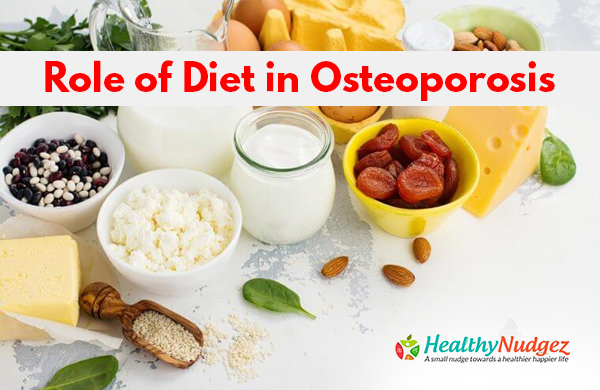Role of Diet in Osteoporosis
Osteoporosis and low bone mass are two major public health problems of the present century. Osteoporosis is the disease of the skeletal system or the bones. It is characterized by low bone mineral mass and deteriorated bone structure, which increases bone brittleness and the risk of fractures. In osteoporosis the loss of bone tissues proceeds faster than bone formation, leading to loss of bone flexibility and stability (for more about causes and symptoms of Osteoporosis, read Osteoporosis- prevention and cure by Dr Uday Ranade, a leading Mumbai Orthopaedic Surgeon at www.healthynudgez.com)
There is an urgent need of developing nutritional approaches for the prevention and treatment of osteoporosis. The change in lifestyle in the recent years is responsible for the increase in the number of people suffering from reduced bone mass, demineralization of the bones and osteoporosis. Until recently the role of nutrition was also not recognised by the majority of population. However, recent researches indicate that there is a major relationship between osteoporosis, lifestyle and nutrition.
Dietary factors that majorly increase the risk of osteoporosis include deficiency of either calcium and vitamin D or both. Other contributing factors are genetic predisposition, low body weight, smoking, excessive consumption of caffeine and long periods of immobilisation.
We all know that Calcium is required for the normal growth and development of bones. Along with taking adequate calcium in diet, it is important to note that the absorption of the dietary calcium is also important. Certain food components or nutrients improve the availability of calcium in the body and certain others may negatively influence calcium absorption. Important sources of calcium include:
- Dairy products such as milk, yogurt, cheese (both cottager cheese and processed cheese)
- Dark green leafy vegetables such as spinach, fenugreek leaves and mustard greens
- Nuts, especially almonds as they are among the highest sources of calcium
- Some oil seeds like poppy seeds and sesame seeds
- Fish with edible bones such as sardines and salmon
- Beans and lentils
- Certain cereals like ragi
- Fortified Cereals, certain packaged breakfast cereals like oats and some breads these days are fortified with calcium
The recommended calcium intake changes with age. Numerous studies have shown that higher calcium intake at various ages is associated with higher bone mineral density. It is important to note that one of the highest intakes are required after the age of 50 especially in females. Also, children need more calcium as compared to adults per kg body weight, for growing bones. According to the Indian Council of Medical Research, the RDA for children 600 mg per day for 1 to 9 years and 800mg per day from 10 to 17 years of age. Around 1200 mg calcium is required for pregnant and lactating mothers and after the age of 50 (post-menopausal age).
Some important facts about calcium:
- Vitamin D is essential for the absorption of adequate calcium
- Certain anti-nutrients such as oxalates (present in leafy vegetables) and phytates in cereals, decrease the absorption calcium from food. So, it is important to cook (boil) these foods as it reduces their oxalate content. Also, important is to have good gut health, as some friendly bacteria in the gut reduce absorption of oxalate and therefore. Promote absorption of calcium (and other minerals).
Vitamin D is synthesised in the skin, on exposure to ultra violet rays of the sun (25 minutes per day, preferably morning sun). The synthesis of vitamin D by the skin is reduced with age. Vitamin D is important as it lowers the risk of fractures by improving the absorption of calcium from the gut and into the bones. Vitamin D is found naturally in very few foods. Being a fat-soluble vitamin, its sources include:
- fatty fish like tuna and mackerel and salmon
- fish-liver oil (cod-liver oil) and
- liver
- Cheese
- Egg Yolk
- Some packaged foods and milk are also fortified with Vitamin D
A very important fact is about Vitamin D is as it is a fat-soluble vitamin, it needs fat for its absorption from the gut. Therefore, whenever vitamin D supplements are to be taken, they must be consumed along with fatty foods such as butter cream, full cream milk, etc.
Apart from these other nutrients of importance in bone health are:
- Phosphorus: Adequate phosphorus intake is essential for bone building during growth, excess phosphorus intake combined with low calcium intake have a deleterious effect on bone mineral mass. Adequate intake of phosphorus in combination with calcium is required for the mineralization of the bones. Rich sources of phosphorus include milk and milk products, poultry, meat, fish, eggs, grains and legumes. Only milk and milk products have both calcium and phosphorus.
- Potassium and vitamin K both reduce excretion of calcium through urine and promote absorption of calcium into the bones. All citrus fruits, fresh fruits and vegetables, legumes and milk are rich sources of potassium. Vitamin K is present in dark green leafy vegetables, fruits and vegetable oils. In small quantities it is also present in dairy products and grains.
- Sodium causes increased loss of calcium through urine. Higher salt intake has a negative effect on bone mineralization and causes loss of calcium from the bones.
Energy-dense diets that lack other nutrients have been seen to have a negative effect on bone health. Diets high in meat and low in fruits and vegetables increase calcium excretion and increase outflow of calcium from bones.
In conclusion, intake of diets with high dairy products consisting of milk, cheese and yogurt along with good quantities of fruits and vegetables, decrease the risk of osteoporosis and diets high in sugar, oils and refined cereals are associated with increased risk.

